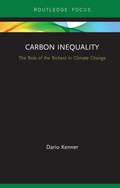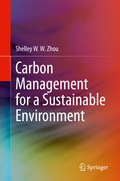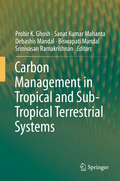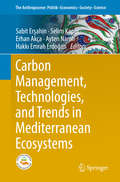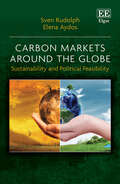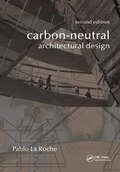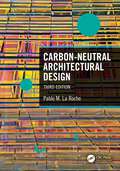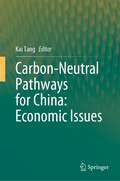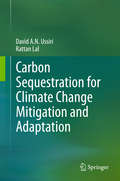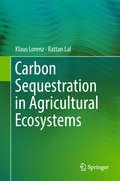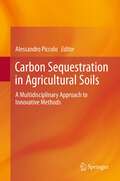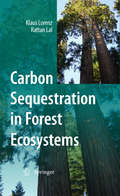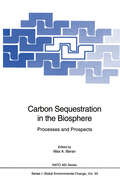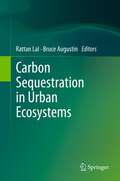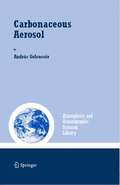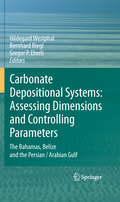- Table View
- List View
Carbon Inequality: The Role of the Richest in Climate Change (Routledge Focus on Environment and Sustainability)
by Dario KennerWith a specific focus on the United States and the United Kingdom, Carbon Inequality studies the role of the richest people in contributing to climate change via their luxury consumption and their investments. In an innovative contribution, it attempts to quantify personal responsibility for shareholdings in large fossil fuel companies. This book explores the implications of the richest people’s historic responsibility for global warming, the impacts of which affect them less than most others in global society. Kenner analyses how the richest people running large oil and gas companies have successfully used their political influence to lobby the US and UK government. This assessment of their growing political power is particularly pertinent at a time of increasing inequality and growing public awareness of the impact of climate change. The book also highlights the crucial role of the richest in blocking the low-carbon transition in the US and the UK, exploring how this could be countered to ensure fossil fuels are fully replaced by renewable energy. This book will be of great relevance to scholars and policy makers with an interest in inequality, climate change and sustainability transitions.
Carbon Management for a Sustainable Environment
by Shelley W. ZhouThis textbook presents students with a systematic approach for the quantification and management of greenhouse gas emissions (GHG) and provides best practices for optimal carbon management and quantification. The book begins with an overview of climate change basics and goes on to discuss carbon footprint measurements, carbon management concepts, and concludes by presenting carbon reduction solutions with applications for green buildings, smart transportation, waste management, and carbon trading and offsetting. The author provides practical examples and carbon management models that support innovative reduction solutions and presents a roadmap for the implementation and development of carbon management strategies, making it a useful resource for both upper undergraduate and graduate students as well as practitioners seeking a comprehensive framework to conduct carbon management.
Carbon Management for Promoting Local Livelihood in the Hindu Kush Himalayan (HKH) Region
by Victor R. Squires Zhanhuan Shang A. Allan Degen Muhammad Khalid RafiqThis book contributes to our understanding of linkages between carbon management and local livelihoods by taking stock of the existing evidence and drawing on field experiences in the Hindu Kush Himalayan (HKH) region, an area that provides fresh water to more than 2 billion people and supports the world’s largest population of pastoralists and millions of livestock. This edited volume addresses two main questions: 1. Does carbon management offer livelihood opportunities or present risks, and what are they? 2. Do the attributes of carbon financing alter the nature of livelihood opportunities and risks? Chapters analyze the most pressing deficiencies in understanding carbon storage in both soils and in above ground biomass, and the related social and economic challenges associated with carbon sequestration projects. Chapters deliver insights to both academics from diverse disciplines (natural sciences, social sciences and engineering) and to policy makers.
Carbon Management in Tropical and Sub-Tropical Terrestrial Systems
by Probir K. Ghosh Sanat Kumar Mahanta Debashis Mandal Biswapati Mandal Srinivasan RamakrishnanSoil organic carbon (SOC), a key component of the global carbon (C) pool, plays an important role in C cycling, regulating climate, water supplies and biodiversity, and therefore in providing the ecosystem services that are essential to human well-being. Most agricultural soils in temperate regions have now lost as much as 60% of their SOC, and as much as 75% in tropical regions, due to conversion from natural ecosystems to agricultural uses and mainly due to continuous soil degradation. Sequestering C can help to offset C emissions from fossil fuel combustion and other C-emitting activities, while also enhancing soil quality and long-term agronomic productivity. However, developing effective policies for creating terrestrial C sinks is a serious challenge in tropical and subtropical soils, due to the high average annual temperatures in these regions. It can be accomplished by implementing improved land management practices that add substantial amounts of biomass to soil, cause minimal soil disturbance, conserve soil and water, improve soil structure, and enhance soil fauna activity. Continuous no-till crop production is arguably the best example. These soils need technically sound and economically feasible strategies to sustainably enhance their SOC pools. Hence, this book provides comprehensive information on SOC and its management in different land-use systems, with a focus on preserving soils and their ecosystem services. The only book of its kind, it offers a valuable asset for students, researchers, policymakers and other stakeholders involved in the sustainable development and management of natural resources at the global level.
Carbon Management, Technologies, and Trends in Mediterranean Ecosystems (The Anthropocene: Politik—Economics—Society—Science #15)
by Sabit Erşahin Selim Kapur Erhan Akça Ayten Namlı Hakkı Emrah ErdoğanThis book pursues a unique approach, investigating both the ecological and socio-economic aspects of carbon management in Mediterranean ecosystems. All chapters are based on papers originally presented at the 1st Istanbul Carbon Summit, held at Istanbul Technical University, 2–4 April, 2014, and revised following a peer-review process.The book addresses the summit’s three main themes – carbon management, carbon technologies, and carbon trends – while also offering chapters on the economic aspects of carbon management and the ecological aspects of the carbon cycle. The chapters on economic aspects analyze the carbon trade and its institutional, political, and legislative structures in different Mediterranean nations, while those on ecological aspects review the discourse on and analysis of the related ecological factors and their feedback due to governance processes.
Carbon Markets Around the Globe: Sustainability and Political Feasibility
by Sven Rudolph Elena AydosIn this timely book, Sven Rudolph and Elena Aydos take an interdisciplinary approach that combines sustainability economics, political economy and legal concepts to answer two fundamental questions: How can carbon markets be designed to be effective, efficient and just at the same time? And how can the political barriers to sustainable carbon markets be overcome?The first part of the book develops an innovative and robust Sustainable Model Rule for evaluating carbon market design, which is demonstrated in practice through chapters assessing the vast majority of real-life emissions trading schemes (ETS) from around the world. In the second part, the focus shifts to political feasibility, providing a political economy framework for evaluating ETS. The authors examine empirical data from case studies in several countries, and identify strategies and policy windows for implementing truly sustainable ETS.The cutting-edge tools outlined in this book for conducting assessments of carbon market design and feasibility will be invaluable for climate policy practitioners and environmental lawyers at national and international levels. The book will also be an important resource for policy makers, think tanks and stakeholders, as well as for scholars and students in environmental economics and climate change law and policy.
Carbon-Neutral Architectural Design
by Pablo M. La RocheThe energy used to operate buildings is one of the most significant sources of greenhouse gas emissions. While it is possible to reduce emissions through climate-responsive design, many architects are not trained to do this. Filling an urgent need for a design reference in this emerging field, this book describes how to reduce building-related greenhouse gas emissions through appropriate design techniques. It presents strategies to achieve CO2 reductions, with an emphasis on control of energy flows through the building envelope and passive heating and cooling strategies. This new, revised edition is updated throughout, and includes a new chapter on building simulations.
Carbon-Neutral Architectural Design
by Pablo M. La RocheThe energy used to operate buildings is one of the most significant sources of greenhouse gas emissions. While it is possible to reduce emissions through climate-responsive design, many architects are not trained to do this. Filling an urgent need for a design reference in this emerging field, this book describes how to reduce building-related greenhouse gas emissions through appropriate design techniques. It presents strategies to achieve CO2 reductions, with an emphasis on control of energy flows through the building envelope and passive heating and cooling strategies. This new, revised edition is updated throughout, and includes a new chapter on building simulations.
Carbon-Neutral Architectural Design
by Pablo M. La RocheThe energy used to build and operate buildings is a significant source of greenhouse gas emissions. While it is possible to reduce emissions through low-carbon design, many architects are not trained to do this. Filling an urgent need for a design reference in this emerging field, this book describes how to reduce building-related greenhouse gas emissions through appropriate design techniques. It presents strategies to achieve CO2 reductions, with an emphasis on control of energy flows through the building envelope and passive cooling and heating strategies. This new, revised edition is updated throughout and includes a new section on embodied carbon and new chapters on daylighting and nature-based cooling.Features: Adds new chapters on daylighting and nature-based cooling with numerous updates throughout the rest of the chapters Presents strategies, illustrated with examples, for new construction and existing buildings to reduce energy consumption and reduce emissions Explains the origins of CO2 emissions associated with the operation and fabrication of buildings: supplying water, disposing of waste from the building, and proposes strategies to reduce them Covers carbon calculations, thermal comfort, indigenous technology, climate‑responsive design, passive cooling and heating, solar design, air flow analysis, daylighting, building simulation and microclimate design with abundant examples Examines siting/location to design buildings that adapt and mitigate their effect on climate change
Carbon-Neutral Architectural Design
by Pablo M. La RocheThe energy used to build and operate buildings is a significant source of greenhouse gas emissions. While it is possible to reduce emissions through low-carbon design, many architects are not trained to do this. Filling an urgent need for a design reference in this emerging field, this book describes how to reduce building-related greenhouse gas emissions through appropriate design techniques. It presents strategies to achieve CO2 reductions, with an emphasis on control of energy flows through the building envelope and passive cooling and heating strategies. This new, revised edition is updated throughout and includes a new section on embodied carbon and new chapters on daylighting and nature-based cooling.Features: Adds new chapters on daylighting and nature-based cooling with numerous updates throughout the rest of the chapters Presents strategies, illustrated with examples, for new construction and existing buildings to reduce energy consumption and reduce emissions Explains the origins of CO2 emissions associated with the operation and fabrication of buildings: supplying water, disposing of waste from the building, and proposes strategies to reduce them Covers carbon calculations, thermal comfort, indigenous technology, climate‑responsive design, passive cooling and heating, solar design, air flow analysis, daylighting, building simulation and microclimate design with abundant examples Examines siting/location to design buildings that adapt and mitigate their effect on climate change
Carbon-Neutral Pathways for China: Economic Issues
by Kai TangThis book provides comprehensive economic analyses on the paths to net-zero for China. It gives a detailed overview of issues and challenges related to carbon neutrality of the global largest emitter which have not been adequately addressed e.g., reduction costs and efficiency of existing actions, the multiple impacts of the newly established carbon market, and the potentials and costs of nature-based solutions such as biophysical sequestration, etc. Studies on China’s carbon reduction have attracted scientists and policymakers from diverse backgrounds. Pursuing a holistic and systematic approach, the book establishes a fundamental framework for this topic, emphasizing the importance of integrated technical-economic-policy analysis. This book will not only be an essential reference to the carbon-neutral progress in China but also will be an outstanding text book on carbon-neutral management. Similarly, this book is expected to attract a great range of readership including undergraduate and postgraduate students, economic and climate specialists, researchers and policymakers in China as well as in overseas.
Carbon Neutrality: Follow the Money (Springer Climate)
by Marko HakovirtaThis book offers a fresh, comprehensive outlook on a paramount global challenge: climate change, seamlessly integrating intricate themes like climate science, innovative technology solutions, strategic business models, essential investments, and societal impacts. The book targets decision-makers, business leaders, educators, and those seeking a comprehensive grasp of this critical issue. It imparts insights into the necessary strategic alignment to understand and address the diverse elements required for mitigating and adapting to climate change effects. As a practical guide, it delineates a clear roadmap for implementing solutions and driving essential transformations. By fusing these multifaceted aspects, the book constructs a comprehensive framework that offers astute guidance for navigating the path towards achieving global carbon neutrality and effectively combatting climate change.
Carbon Sequestration and Its Role in the Global Carbon Cycle (Geophysical Monograph Series #183)
by Brian J. McPherson Eric T. SundquistPublished by the American Geophysical Union as part of the Geophysical Monograph Series, Volume 183.For carbon sequestration the issues of monitoring, risk assessment, and verification of carbon content and storage efficacy are perhaps the most uncertain. Yet these issues are also the most critical challenges facing the broader context of carbon sequestration as a means for addressing climate change. In response to these challenges, Carbon Sequestration and Its Role in the Global Carbon Cycle presents current perspectives and research that combine five major areas: The global carbon cycle and verification and assessment of global carbon sources and sinks Potential capacity and temporal/spatial scales of terrestrial, oceanic, and geologic carbon storage Assessing risks and benefits associated with terrestrial, oceanic, and geologic carbon storage Predicting, monitoring, and verifying effectiveness of different forms of carbon storage Suggested new CO2 sequestration research and management paradigms for the future. The volume is based on a Chapman Conference and will appeal to the rapidly growing group of scientists and engineers examining methods for deliberate carbon sequestration through storage in plants, soils, the oceans, and geological repositories.
Carbon Sequestration and Its Role in the Global Carbon Cycle (Geophysical Monograph Series #183)
by Brian J. McPherson Eric T. SundquistPublished by the American Geophysical Union as part of the Geophysical Monograph Series, Volume 183.For carbon sequestration the issues of monitoring, risk assessment, and verification of carbon content and storage efficacy are perhaps the most uncertain. Yet these issues are also the most critical challenges facing the broader context of carbon sequestration as a means for addressing climate change. In response to these challenges, Carbon Sequestration and Its Role in the Global Carbon Cycle presents current perspectives and research that combine five major areas: The global carbon cycle and verification and assessment of global carbon sources and sinks Potential capacity and temporal/spatial scales of terrestrial, oceanic, and geologic carbon storage Assessing risks and benefits associated with terrestrial, oceanic, and geologic carbon storage Predicting, monitoring, and verifying effectiveness of different forms of carbon storage Suggested new CO2 sequestration research and management paradigms for the future. The volume is based on a Chapman Conference and will appeal to the rapidly growing group of scientists and engineers examining methods for deliberate carbon sequestration through storage in plants, soils, the oceans, and geological repositories.
Carbon Sequestration for Climate Change Mitigation and Adaptation
by David A. Ussiri Rattan LalThis book provides an understanding of the role of human activities in accelerating change in global carbon cycling summarizes current knowledge of the contemporary carbon budget. Starting from the geological history, this volume follows a multidisciplinary approach to analyze the role of human activities in perturbing carbon cycling by quantifying changes in different reservoirs and fluxes of carbon with emphasis on the anthropogenic activities, especially after the industrial revolution. It covers the role of different mitigation options – natural ecological, engineered, and geoengineered processes as well as the emerging field of climate engineering in avoiding dangerous abrupt climate change. Although the targeted audience is the educators, students, researchers and scientific community, the simplified analysis and synthesis of current and up to date scientific literature makes the volume easier to understand and a tool policy makers can use to make an informed policy decisions.
Carbon Sequestration in Agricultural Ecosystems
by Klaus Lorenz Rattan LalA comprehensive book on basic processes of soil C dynamics and the underlying factors and causes which determine the technical and economic potential of soil C sequestration. The book provides information on the dynamics of both inorganic (lithogenic and pedogenic carbonates) and organic C (labile, intermediate and passive). It describes different types of agroecosystems, and lists questions at the end of each chapter to stimulate thinking and promote academic dialogue. Each chapter has a bibliography containing up-to-date references on the current research, and provides the state-of-the-knowledge while also identifying the knowledge gaps for future research. The critical need for restoring C stocks in world soils is discussed in terms of provisioning of essential ecosystem services (food security, carbon sequestration, water quality and renewability, and biodiversity). It is of interest to students, scientists, and policy makers.
Carbon Sequestration in Agricultural Soils: A Multidisciplinary Approach to Innovative Methods
by Alessandro PiccoloThis compilation of techniques, methodologies and scientific data arises from a four-year Italian research project, which took place at university research stations in Turin, Piacenza, Naples and Potenza. Soil Organic Matter (SOM) represents an active and essential pool of the total organic carbon on the planet. Consequently, even small changes in this SOM carbon pool may have a significant impact on the concentration of atmospheric CO2. Recent new understanding of the chemical nature of SOM indicates that innovative and sustainable technologies may be applied to sequester carbon in agricultural soils. Overall results of the project have been applied to develop an innovative model for the prediction and description, both quantitatively and qualitatively, of carbon sequestration in agricultural soils. This book provides experts in different areas of soil science with a complete picture of the effects of new soil management methods and their potentials for practical application in farm management.
Carbon Sequestration in Forest Ecosystems
by Klaus Lorenz Rattan LalCarbon Sequestration in Forest Ecosystems is a comprehensive book describing the basic processes of carbon dynamics in forest ecosystems, their contribution to carbon sequestration and implications for mitigating abrupt climate change. This book provides the information on processes, factors and causes influencing carbon sequestration in forest ecosystems. Drawing upon most up-to-date references, this book summarizes the current understanding of carbon sequestration processes in forest ecosystems while identifying knowledge gaps for future research, Thus, this book is a valuable knowledge source for students, scientists, forest managers and policy makers.
Carbon Sequestration in the Biosphere: Processes and Prospects (Nato ASI Subseries I: #33)
by Max A. BeranAnthropogenic release of carbon dioxide into the atmosphere has been recognized as the primary agent in global climate change. The volume discusses the possibilities for limiting that increase by the long-term storage of carbon in soils, vegetation, wetlands and oceans. Each of these storage media is analysed in detail to elucidate those processes responsible for the uptake and release of carbon. Several chapters address the practical prospects for deliberate interventions aimed at adjusting the balance in favour of uptake over release, i.e. sequestration, while having regard to simultaneous changes in the various environments.
Carbon Sequestration in Urban Ecosystems
by Rattan Lal and Bruce AugustinUrbanization drastically alters the ecosystems structure and functions, disrupts cycling of C and other elements along with water. It alters the energy balance and influences climate at local, regional and global scales. In 2008, urban population exceeded the rural population. In 2050, 70% of the world population will live in urban centers. The number of megacities (10 million inhabitants) increased from three in 1975 to 19 in 2007, and is projected to be 27 in 2025. Rapid urbanization is altering the ecosystem C budget. Yet, urban ecosystems have a large C sink capacity in soils and biota. Judicious planning and effective management can enhance C pool in urban ecosystems, and off-set some of the anthropogenic emissions. Principal components with regards to C sequestration include home lawns and turfs, urban forests, green roofs, park and recreational/sports facilities and urban agriculture.
Carbonaceous Aerosol (Atmospheric and Oceanographic Sciences Library #30)
by András GelencsérThe concept of carbonaceous aerosol has only recently emerged from atmospheric pollution studies; even standard nomenclature and terminology are still unsettled. This monograph is the first to offer comprehensive coverage of the nature and atmospheric role of carbonaceous aerosol particles. Atmospheric chemists, physicists, meteorologists, and modellers will find this a thought-inspiring and sometimes provocative overview of all global phenomena affected by or related to carbonaceous aerosol.
Carbonate Cementation in Sandstones: Distribution Patterns and Geochemical Evolution (International Association Of Sedimentologists Series #72)
by Sadoon MoradCarbonate cements are very common and abundant in clastic sequences. They profoundly influence the quality of hydrocarbon reservoirs and supply important information on palaeoenvironments and the chemical composition and flow patterns of fluids in sedimentary basins. Despite this importance, their distribution patterns in time and space and their geochemical evolution are not yet deeply explored and elucidated. This Special Publication contains 21 review papers and case studies on carbonate cementation in clastic sequences written by invited specialists on the subject. These papers present a wide and deep coverage that enhance our knowledge about carbonate cementation in various clastic depositional environments, tectonic settings and burial histories. The book will be of special interest to researchers, petroleum geologists and teachers and students at the postgraduate level. If you are a member of the International Association of Sedimentologists, for purchasing details, please see: http://www.iasnet.org/publications/details.asp?code=SP26
Carbonate Depositional Systems: The Bahamas, Belize and the Persian/Arabian Gulf
by Hildegard Westphal Bernhard Riegl Gregor P. P. EberliCarbonate sediments are of increasing relevance for archives of past environmental conditions and for economical reasons in areas of geothermal energy and hydrocarbon reservoirs. Complex interaction of physical and chemical parameters with biological parameters determines the architecture and composition of carbonate sedimentary bodies. This book closes some of the still existing gaps in our understanding of the influence and interplay of physical, chemical, and biological parameters with carbonate sedimentation. An understanding of this interaction is not only required for reliable prediction of reservoir quality but also for a robust interpretation of environmental conditions in the past and the present. It is written by geologists for geologists in order to provide an easily accessible overview of the large amount of relevant information provided by the neighbouring sciences. The approach of the book is to document the modern depositional environments of three classical areas of carbonate deposition, each characteristic for a specific sedimentological setting (isolated platform, attached shelf, ramp) in order to assess both the range of physical, biological and chemical parameters and their sedimentary response. This book presents a comprehensive compilation based on data from published work and unpublished theses, and the integration of these data in order to extract previously undiscovered relationships between the discussed parameters and carbonate deposition.
Carbonate Diagenesis (International Association Of Sedimentologists Series #69)
by R. G. C. Bathurst Maurice E. TuckerOver the years, many papers on carbonate diagenesis have been published in Sedimentology, the journal of the International Association of Sedimentologists. This volume presents a collection of these papers with a commentary. The emphasis of the book is on the diagenesis of shallow-marine carbonate sediments and the editors have chosen 12 papers which are reproduced in full. To widen the scope of this volume the abstracts for another 16 papers are presented. These provide further examples of diagenetic studies and help to extend the coverage of the book. The reprints and abstracts are divided into three groups, dealing with marine, meteoric and burial diagenesis respectively. Each collection is preceded by a commentary which briefly summarizes the topic and introduces the reprints and abstracts to come
Carbonate Facies in Geologic History (Springer Study Edition)
by J.L. WilsonSince 1950 geologists have learned more about the origin and lithification of carbonate sediments than in all the previous years of the history of science. This is true in all the diverse fields of carbonate geology: the study of Recent environments, marine zoology and botany, organic geochemistry, trace element and isotope geochemistry, mineralogy, microfacies of depositional environments, and trace-fossil and sedimentary structure investigation. A synthesis of this new knowledge is just beginning to be formulated. The purpose of this volume is to introduce the advanced student and petroleum explorationist principally to one important aspect of this study: to some of the principles of carbonate geology which may serve to interpret the depositional environments of ancient strata and to better define their sequences and patterns. Chapter I is a brief review of principles of carbonate sedimentation. (For a full discussion of the mineralogy, geochemistry, and diagenesis of carbonates along with a review of Holocene sediments, one may refer to Bathurst's (1971) and Milliman's (1974) texts.) Chapter II reviews stratigraphic and paleotectonic concepts and discusses a general model for carbonate deposition. Chapter III offers an outline of carbonate petrography, concentrating on lithologic descrip tion for the purposes of environmental interpretation. For a further review of this subject and excellent photomicrographs, Horowitz and Potter (1971) and Majewske (1969) may be used.
